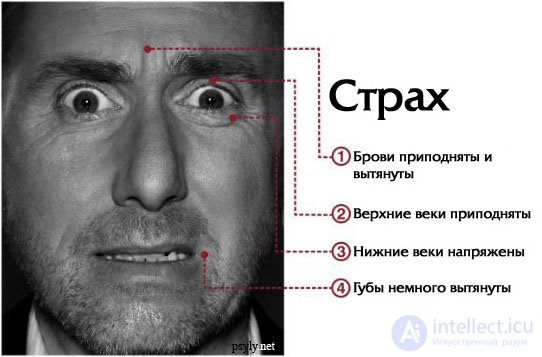
Experience of fear
People are afraid of causing any harm. Harm can be physical, moral, or both. Physical harm can be very different - from something insignificant, such as pain from a syringe injection during vaccination to severe injuries that threaten a person’s life. Moral damage can also vary widely - from petty offenses and disappointments to serious emotional trauma caused by threats to well-being, rejected by love or insults of human dignity. Moral damage may involve damage (self-esteem, self-confidence, personal safety) or loss of love, friendship, faith, etc. In the general case, harm may involve both physical pain and moral suffering: for example, a teenager beaten by his rival on the eyes of his girlfriend will suffer both physical and moral damage.
Human survival depends on the ability to avoid situations in which he may be hurt and caused physical damage. You learn to foresee the danger from early childhood. You assess what is happening and warn yourself about the possibility of harm to you. Very often, even before hurting, you feel a sense of fear. You are afraid of both real and imaginary threats. You are afraid of events, people, animals, objects or ideas that seem dangerous to you. If you are told that next week you should be given some very painful rabies shots, then you will probably feel fear long before the first injection. If you see that your boss is out of sorts and is able to explode because of any little things, then you begin to fear his anger even before he turns his attention to you. The fear of danger, the expectation of physical pain can often be even more difficult to bear than the pain itself. Of course, sometimes the fear of danger mobilizes efforts to help avoid the expected harm or at least minimize it.
Fear is so often felt before real harm (you successfully recognize the danger before you feel pain), that sometimes you completely forget about the possibility of being caught unawares. Reflection, planning, evaluation and foresight do not always protect or even warn you. From time to time, you get painful blows without warning and, when it happens, you feel fearlessly without any preliminary thoughts about what is happening to you. Fear can be felt almost simultaneously with the suffering inflicted. Sudden acute pain causes fear. You do not give yourself time to think about whether you really caused any harm and what is its source. It hurts you and you feel fear. If the pain continues and you have time to assess what is happening, you may be even more afraid: “What if I have a heart attack?” If you burn your hand on the stove, you experience pain and fear (and possibly also disorder). As soon as you pull away your hand, without giving yourself time to think about why the stove was turned on, when you thought it was off, you would feel fear without a pause to think about how seriously you burned. The fear experienced at the same time as the harm to you may also arise in the event of moral suffering. If the boss approaches an office worker who is dormant at his desk, and shouts: “You are fired, you lazy idiot!” - then the employee feels fear (and, perhaps, shows a startled reaction). This person does not need time to think about what is happening, although such thoughts may increase fear even more: “God, I will not be able to pay the mortgage loan!” Or he may have another emotion instead of fear or in combination with him: “ He has no right to talk to me like that - because yesterday I worked until late at night in order to meet the new deadlines that he set. ”
Fear differs from surprise in three important aspects. Fear is a terrible feeling, but surprise is not. Surprise is not necessarily pleasant or unpleasant, but even moderate fear is unpleasant. Strong fear, that is, horror, is perhaps the most traumatic and harmful of all emotions. It causes many changes in our body. The skin of a person who is terrified may turn pale. It can become covered in cold sweat. His breathing quickens, his heart knocks in his chest like a heavy hammer, his pulse rate increases dramatically, and cracks and other unpleasant processes may begin in his stomach. His bladder or intestines may begin to involuntarily empty, and his hands shake slightly. He may find it difficult for him to leave the place where this terrible event unfolds, and although his posture indicates his willingness to flee, he freezes in stillness. You may not experience very strong fear for a long time, as the state of horror debilitates and devastates you.
The second aspect of the difference between fear and surprise is that you may be afraid of something familiar to you, which, as you know, is about to happen. You know that the dentist is going to invite you to his office - for you this is not surprising - but you may be afraid of this moment. While waiting for invitations to come to the pulpit to give a lecture or standing backstage while waiting for a call to the stage, you may be afraid, even if you are an experienced lecturer or actor. There are many similar situations that make people fear the second, tenth, or twentieth time when they know they have to go through some kind of test. When fear is experienced suddenly, when there is no expectation of danger, and fear arises simultaneously with the harm caused, then such an experience can be complemented by a slight surprise. Thus, in many such instances of instant fear, you will experience both fear and surprise or fear and fear.
The third aspect of the difference between fear and surprise is related to the duration of the experience of experiencing these emotions. Surprise is a very brief emotion, but unfortunately, fear does not. Surprise lasts very long. Unforeseen fear or fear experienced at the same time as pain can be short-lived, but sometimes fear can build up gradually. If you have to stay overnight alone in an old house, then even a faint creak may make you a little uneasy. While you are thinking about the cause of this squeak and listening more carefully to any unexpected sounds, your anxiety may slowly turn into fear or even horror. When you are surprised, you are surprised only for a very short time, only until you appreciate the event that surprised you. Fear can last much longer; you may well know the nature of the event that caused your fear, and still remain afraid. For example, during the entire flight you may tremble with fear, waiting for a plane crash. However, a person has a limit of endurance, and fear will exhaust you physically if it is constantly felt in an extremely acute form. Surprise, as a rule, quickly disappears as soon as you assess the event that has occurred, and is reborn into some other emotion, depending on your feeling towards what surprised you. The feeling of fear can stretch for a long time. You can still be afraid even after the danger has passed. If the danger arises and disappears very quickly, so that you are not aware of what position you were in until you left it - as in the case of a possible car accident that you miraculously avoided - you can only be afraid later.
Fear varies in intensity - from fear to horror. The intensity of the fear experienced depends on the event or how you evaluate the event. When fear arises at the same time as the harm done, the degree of fear will obviously reflect the degree of suffering you experience. If the suffering continues, the fear can become more severe if you expect the suffering to increase or become difficult to bear. When fear arises as a reaction to danger — rather to the threat of harm than to the harm itself, the intensity of fear depends on your assessment of the degree of future harm and your ability to cope with it, avoid or weaken it, or at least survive it. In threatening situations, you may just feel scared if you know that you can avoid the danger of fleeing or that your suffering will not be really hard. But when escape is impossible and when the expected harm is significant, your fear can turn into horror — you will be numb and stuck in a pose that demonstrates your complete helplessness.
Fear can be replaced by other emotions or their complete absence. You may experience anger and lash out at the source of the danger, or you may experience anger or self-loathing for putting yourself at serious risk or showing fear. Fear can be disheartened if you continue to suffer damage or if the negative consequences of danger are manifested to you in other forms. More complex sequences of emotions are possible: for example, you may experience fear, then anger, then despondency, etc. Fear may also be experienced with other emotions if an event simultaneously causes two feelings. For example, if someone threatens you, then you may experience the fear of a possible attack, and anger at the person who provokes you.
Joy can replace fear. You can rejoice in the fact that you managed to avoid danger, or, even if you had to suffer, rejoice in the fact that it ended. Some people are able to enjoy their fear. For them, the threat of possible harm is a challenge that aggravates the blood and sets the goal. Such people are called courageous, courageous or fearless. They can be soldiers, climbers, roulette players, car racers, etc. But many more people enjoy the feeling of a pseudostrache experienced, for example, on some attractions in amusement parks. There is a risk of harm, but we all know that it is not real. Of course, there are people who can barely tolerate fear. They cannot even bear the feeling of a pseudo-contract. Fear suppresses them so much that they plan their lives with the utmost care, trying to provide themselves with all kinds of protection or to avoid everything that can scare them. Such people get little satisfaction from overcoming fear; their experience of fear is too painful for them.
What does fear look like
There are characteristic forms of reflection of fear on each of the three areas of the face: eyebrows raised and slightly reduced; eyes open and lower eyelids tense; lips drawn back.
Brows

Picture 1
Eyebrows look raised and straightened. In fig. 1 shows frightened eyebrows (B) and surprised eyebrows (A). Note that frightened eyebrows are raised (1), as are surprised eyebrows, but apart from this, they are slightly reduced, so that in a person who is afraid, the inner edges of the eyebrows (2) are closer to each other than in a person who is surprised. Horizontal wrinkles usually appear over frightened eyebrows across the forehead (3), but they usually do not cross the entire forehead, as is the case with surprise (4).
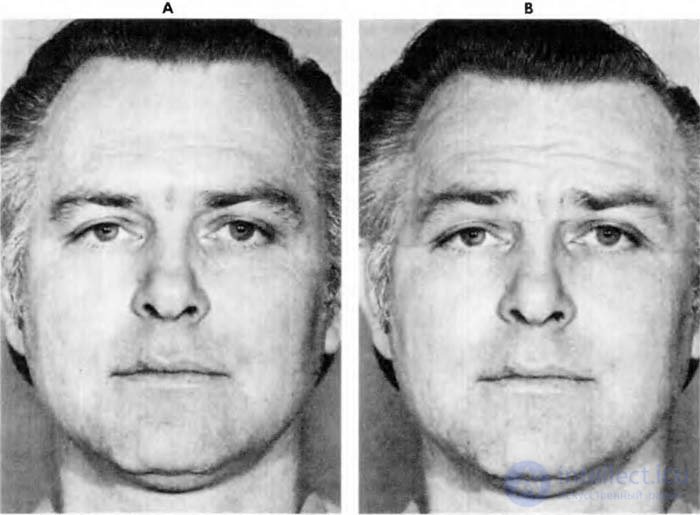
Figure 2
Although frightened eyebrows are usually complemented by frightened eyes and a frightened mouth, sometimes they appear on a neutral face. When this happens, the facial expression conveys the message associated with fear. In fig. 2B John's facial expression is shaped by frightened eyebrows and completely neutral other elements of the face. Figure 2A shows, for comparison, John’s completely neutral expression. When the eyebrows are held in a frightened position, as in fig. 2B, the person expresses anxiety, mild anxiety, or controlled fear. Figure 2 again demonstrates that a change in one part of the face changes the overall impression. It seems that anxiety also appears in the eyes of John and even a little in the bend of his mouth. But this is a composite photo in which frightened eyebrows were transferred to a neutral face, shown on the left. If you close your eyebrows and forehead on each of the photos, you will see that the eyes and mouth on them are exactly the same.
EYES
Figure 3
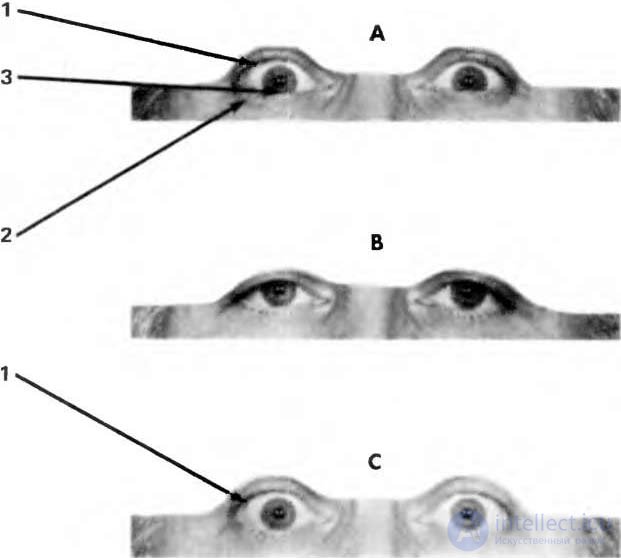
The eyes of the fearful person are open and tense, the upper eyelids are raised and the lower eyelids are stretched. In fig. 3A shows scared eyes (A), neutral eyes (B) and surprised eyes (C). Note that in the frightened and surprised eyes the upper eyelids are raised, this allows you to see the sclera (protein) above the iris (1). With fear and surprise, the upper eyelids are equally movable, and the lower eyelids are different: they are tense and raised in the case of fear (2) and relaxed in the case of surprise. Stress and elevation of the lower eyelids with fear can cause these eyelids to cover part of the iris (3).
Frightened eyes can usually be observed on the face with frightened eyebrows and a frightened mouth, but sometimes fear is only expressed through the eyes. In this case, it will be a very quick expression, in which the eyes instantly take on a frightened look. If this happens, then usually this expression of fear is genuine, although the fear itself is either weak or controllable.
MOUTH
Figure 4
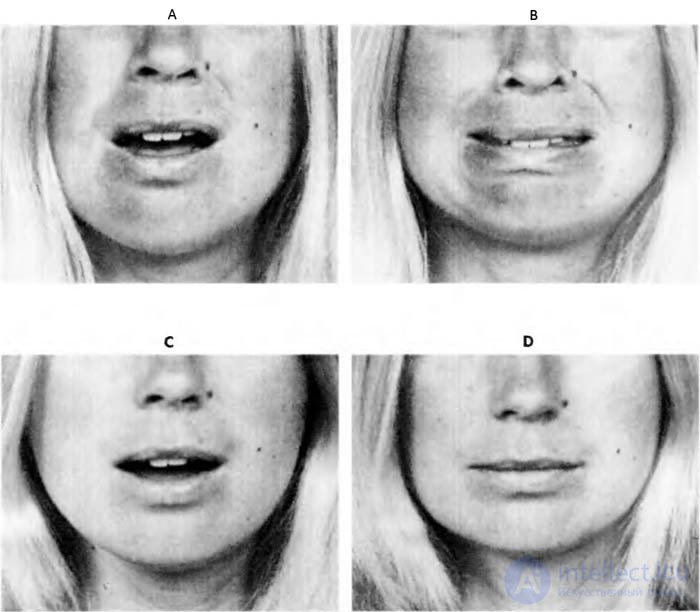
In a person who is fearful, his mouth is open, and his lips are tense and, possibly, heavily pulled back. In fig. 4 Patricia demonstrates two types of mouth expression (A and B) and, for comparison, a surprised mouth (C) and a neutral mouth (D). Frightened mouth in pic. 4A is very similar to a surprised mouth (4C), but it has one important difference: his lips are not relaxed, as in the case of surprise his upper lip is tense, and the corners of his lips begin to be pulled back. At the frightened mouth in fig. 4B, the lips are stretched and strained, and the corners of the lips are drawn back.
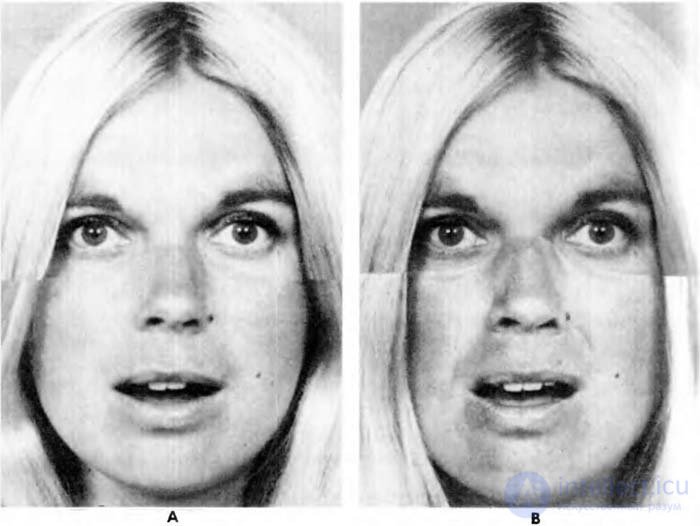
Figure 5
Figure 6
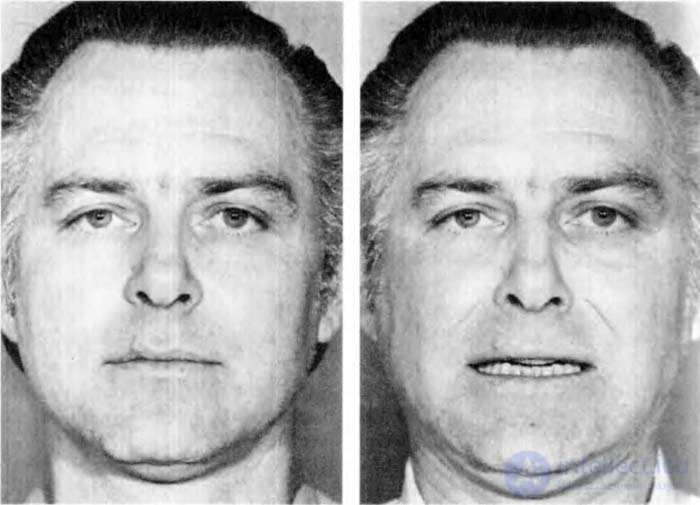
Although a frightened mouth usually appears on the face with frightened eyes and eyebrows, frightened eyebrows and eyes may appear on a neutral face, and their meaning in this case will be different. In fig. 5B Patricia has a more open frightened mouth, and in fig. 5A, for comparison, is a surprised mouth, while in both cases the remaining elements of her face remain neutral. The face in fig. 5B expresses anxiety or fear; it shows a short-term feeling at the initial moment of fear. On the contrary, the facial expression in fig. 5A, discussed in the last chapter, expresses a daze and can arise when a person is really stunned by something or simply depicts this form of his boundless surprise on his face. A more intense, frightened mouth can also appear along with completely neutral other elements of the face, but usually such a mouth corresponds to a brief expression when the lips are pulled back first and then returned to their original place. In fig. 6 shows just such an intense, frightened mouth on a neutral face, and for comparison, the completely neutral face of John. If this expression on the face quickly appears and disappears, then it may mean that John is really scared, but tries not to show it, that John anticipates the emergence of fear or pain, or that John does not feel fear, but mentally turns to some frightening or painful event. An illustration of the last case of an emblematic expression of fear can serve as a person from the example of a failed car accident, which momentarily stretches the mouth when it remembers fear or pain experienced in that situation.
FROM LUNG FEAR TO LIMIT
Figure 7
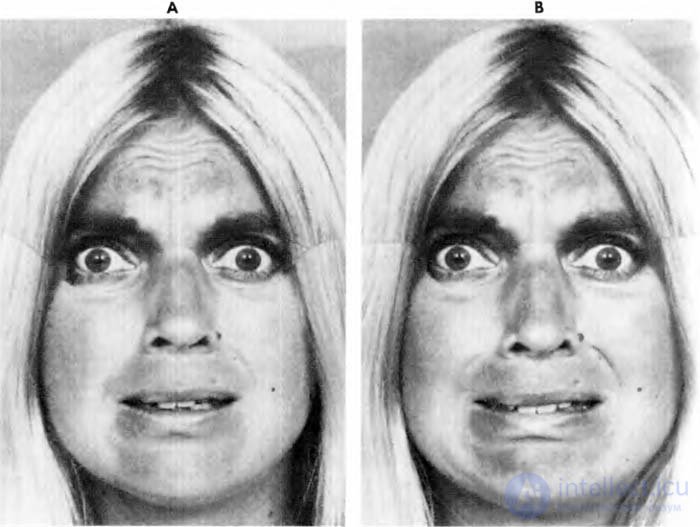
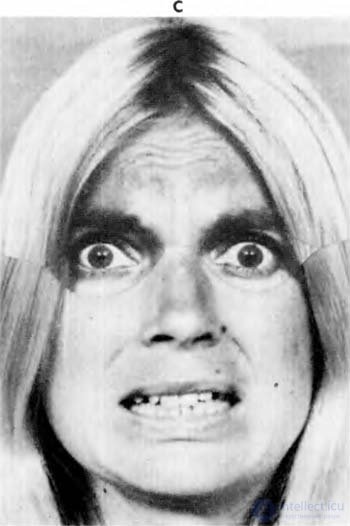
Fear varies in intensity - from fear to horror, and the face reflects all these differences. The intensity of fear is reflected in the appearance of the eyes: as fear increases, the upper eyelids rise higher and the tension of the lower eyelids increases. Even more obvious are the changes of the scared mouth. In fig. 7 Patricia demonstrates an increase in fear (starting with Fig. 7A and further clockwise) by increasing the tension of the mouth, which gradually opens up wider. Although the face in pic. 7C may seem to express more fear than the face in fig. 7A, one should not forget that these photos are also composite, and the frightened eyes and forehead shown on them are exactly the same, and the difference is provided solely by the mouth.
EXPRESSION OF FEAR THROUGH TWO FACIAL AREAS
Fear can manifest itself only in two areas of the face, and the third area can remain neutral. Each of these "dvooblastnyh" expressions of fear has its own, somewhat different from the others, value. In fig. 8 shows two types of this expression of fear. In fig. 8A, John’s face is apprehensive - as if he had just realized the approach of an event that would harm him.This expression has such a value because the lower part of the face remains neutral - fear manifests itself only with the help of eyebrows and eyes. Compare John's facial expressions in pic. 8A and fig. 2B.In both cases, John is apprehensive, but in fig. 8A these fears are stronger than in fig. 2B, because at the last of these, fear is expressed only with the help of the eyebrows, and at the first with the help of the eyebrows and eyes.
Figure 8
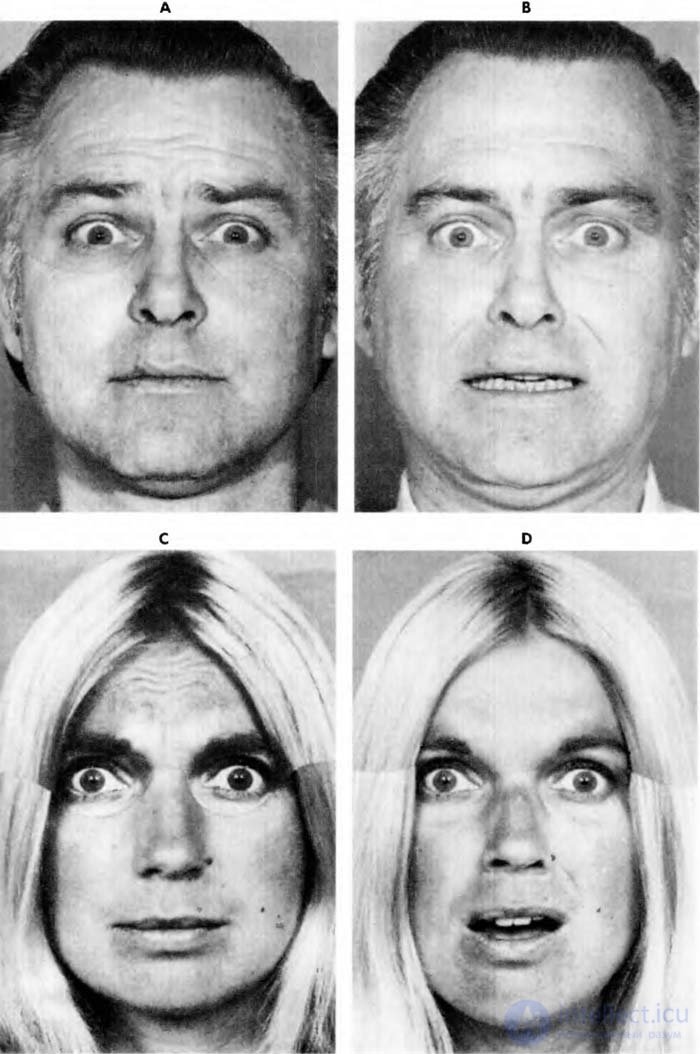
John's expression on fig. 8B shows a stronger fear bordering on horror. Interestingly, the intensity of this expression of fear is not reduced due to the fact that the eyebrows remain neutral. In contrast, the neutral position of the eyebrows creates an expression of sudden torpor.
Patricia demonstrates these different types of fear expressions with a few subtle variations. In fig.8C, her face is apprehensive, because fear is manifested only through the eyebrows and eyes, but not the mouth. This is the same expression as the expression on John's face in the figure above. 8A. In fig.8D Patricia’s face is terrified. This expression is similar to the expression on John's face in fig. 8B, because fear here also manifests itself only with the help of the eyes and the mouth. But her expression is different from that of John, because her frightened mouth is less tense. Patricia looks more amazed at what she saw than frightened, because her frightened mouth looks a lot like a mouth that expresses surprise. Compare this to Patricia's facial expression in pic. 8D with the expression on her face in fig. 5b. In fig.5B she looks only apprehensive, not amazed at what she saw, because fear expresses only her mouth. The effect of a “shock” state, manifested in its expression in fig. 8D, created by the appearance of frightened eyes.
COMBINATION OF FEAR AND AMAZING
Fear can occur simultaneously with sadness, anger or disgust, and mixed expressions of fear with one of these emotions can appear on the face. Fear can also be partially disguised with a cheerful look, and this mixed expression will be shown in one of the photos. All mixed expressions of fear with sadness, anger, disgust, or joy will be presented in subsequent chapters in explaining each of these emotions. The most typical is a mixture of fear and surprise, because the events that frighten us are often unexpected and, as a rule, we are at the same time or almost at the same time both frightened and surprised. In most of these mixed expressions, when one part of the face shows surprise and the other fear, the expression of fear dominates.
In fig.9 shows two types of a mixture of fear and surprise, and for comparison, faces on the left are shown, in all three areas of which only fear is reflected. Looking from left to right, you can see an increase in wonder mixed with fear. In both John and Patricia, the differences between the leftmost and rightmost photos are more pronounced than the differences between adjacent images. This results from the fact that the next photos differ only in one area of the person, and extreme photos differ in two areas.
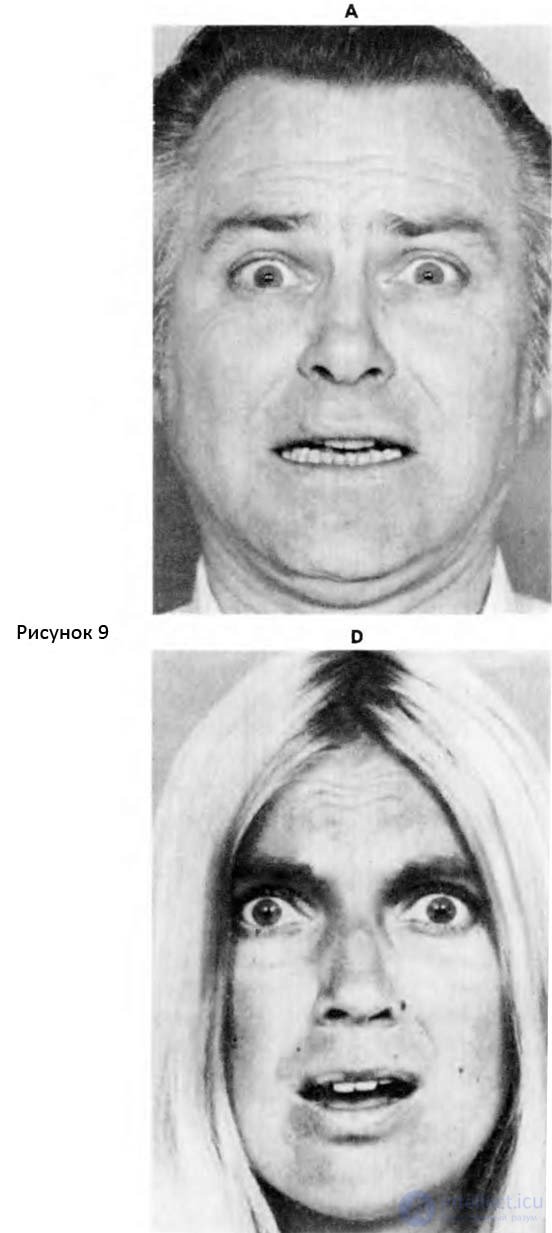
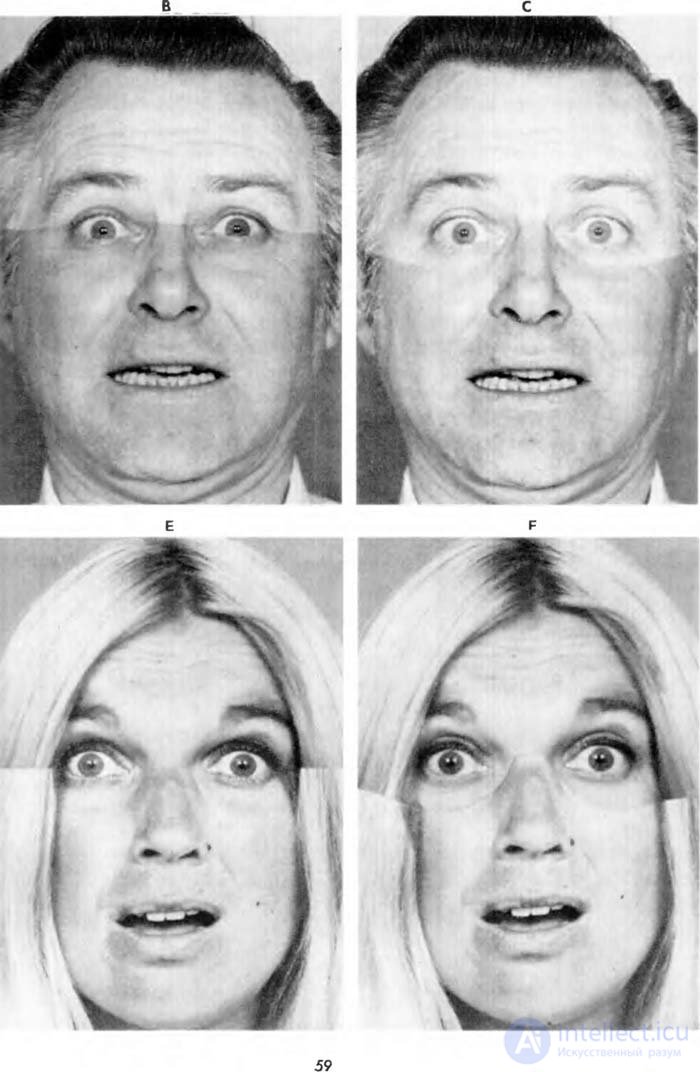
In fig.9B, only the forehead and eyebrows give the face a surprise, while the rest of the face expresses fear. The impression created is only slightly different from the impression from the leftmost photo. In fig.9E, only eyebrows and forehead express surprise, while the rest of the face expresses fear, but the distinction of this face from the one shown on the left, expressing fear in all three areas, is much more obvious. This difference is more pronounced in Patricia than in John, perhaps because Patricia’s mouth here looks more like a surprised man’s mouth.
In the extreme right photos in fig. 9 eyebrows express surprise - forehead and eyes, and fear - only mouth. Although this is true for both Patricia and John, John’s face (Fig. 9C) expresses more fear than Patricia’s face (Fig. 9F). Again, this is due to the way the mouths of Patricia and John express fear. Patricia's startled mouth is very reminiscent of her surprised mouth. If you think that Patricia's face is in pic. 9F expresses only surprise without any admixture of fear, then compare this photo with the photo in fig. 6).
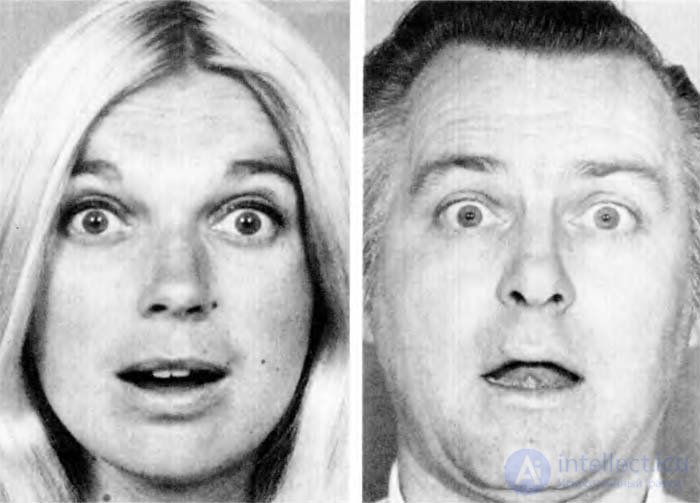
and you will see the difference.
Figure 10 shows two other types of mixed expressions - fear and surprise. In Patricia, only the mouth expresses surprise, and the eyes and eyebrows express fear. She looks scared, but not as much as in fig. 9D, where her face only expresses fear.
Figure 10
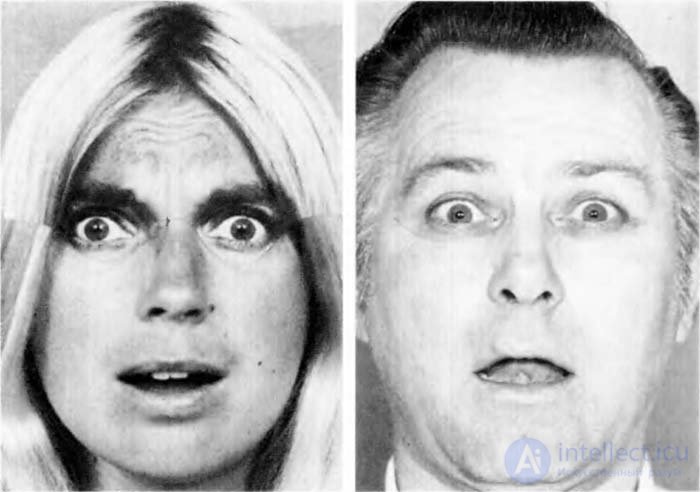
In fig.10 on Patricia’s frightened face, the daze is more pronounced due to her surprised mouth. Compare Patricia's facial expressions in pic. 10 and fig. 8C.
Eyebrows and eyes in both cases look the same, but replacing a neutral mouth (fig. 8C) with a surprised mouth (fig. 10) adds an element of fear and changes the expression of fear (fig. 8C) into an expression of a mixture of stronger fear and distrust.
John's expression on fig. 10 shows the last possible combination of fear and surprise. In this case, the fear of John is expressed only in the eyes. Just due to the pulling up of the lower eyelids, his expression of surprise is replaced by the expression of startled surprise. Compare John's facial expressions in pic. 10 and fig. 6, to see the difference between such a mixture of fear with surprise and the expression of pure surprise.
SUMMARY
In fig. 11 shows two faces expressing fear in all three areas.
Figure 11
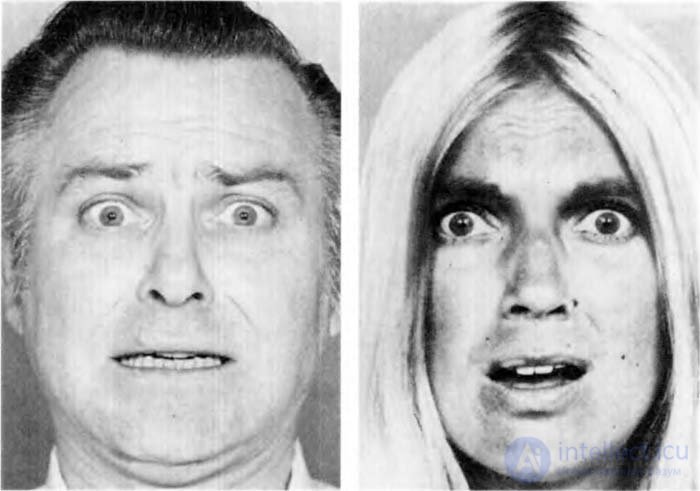
- Eyebrows raised and slightly reduced.
- Wrinkles are observed only in the central part of the forehead, and not across its entire width.
- The upper eyelids rise, exposing the sclera, and the lower eyelids are tense and pulled up.
- The mouth is open, and the lips are either slightly stretched and pulled back or stretched and drawn back.
“CONSTRUCTION” OF PERSONAL EXPRESSIONS
- Put parts C on faces pic. 11. What expression have you got? You have already seen this expression on John’s face. 2, and the expression on Patricia’s face will be the same, albeit a little more subtle. Concern, fear, controlled fear - this is the meaning of possible transmitted messages.
- Наложите части B на лица рис. 11. Какими будут полученные выражения? Лицо Патрисии выражает озабоченность или опасение (рис. 5B). Выражение лица Джона может либо иметь тот же самый смысл, либо оно может выражать контролируемый страх или, если это выражение мгновенно возникает и пропадает, оно может быть эмблематическим выражением страха.
- Наложите на рис. 11 части А и D. На этом лице вы видите испуганные глаза, которые на мгновение можно наблюдать при уверенно контролируемом или при очень слабом страхе.
- Уберите части А. Выражение будет таким же, как и на левых фотографиях на рис. 8, — выражение опасения.
- Remove parts D and return parts A. This expression is shown in the right photos in fig. 8 - expression of a stronger, chilling fear, close to horror. By alternately applying and removing parts A and D, you can best see how facial expressions change.
PHOTO SHOW
Another way to practice the material is to quickly look at the photo of the face, to determine what kind of emotion it expresses. You can do this using photos from previous pages. The procedure itself is quite complex, but most people find it useful for mastering the ability to recognize facial expressions in real life.
You will need:
- A partner who will select photos and show them to you.
- L – shaped cardboard mask; with it, your partner will cover other photos on the same page so that you can only see the face shown to you.
- A list of persons that will be shown to you, with an indication of the order of display; A basic list is provided below, but your partner will have to change it so that you do not know which photo will be displayed next. And of course, it is important for you to know the order of the show so that you can check your answers later.
- An empty table with numbers from 1 to 22, in which you will record your answers.
Your task is to determine which emotion is shown on each of the photos.
EXERCISE 1
Your partner should show you each photo in just one second. Then he must quickly close it, find and mask the next one to show it to you when you finish recording your answer. If you want, then answer at random, but before you check the answers, be sure to review all 22 photos.
If you cope with the task from the first time - you have learned the material well. You have become a specialist in expressing fear and surprise on your face! If you made a few mistakes, read the places where they say about the relevant photos. Then ask your partner to change the order of the show and try the task again.
If you do not cope with the task the first time, do not despair. Many receptive people give absolutely correct answers only on the third or fourth attempt.
Next you will find similar exercises to recognize other emotions. It will be easier for you to cope with these exercises, if you firmly learn the material dedicated to FEAR and AMAZING, before moving on.












 and you will see the difference.
and you will see the difference.

Comments
To leave a comment
Psychology of emotions
Terms: Psychology of emotions